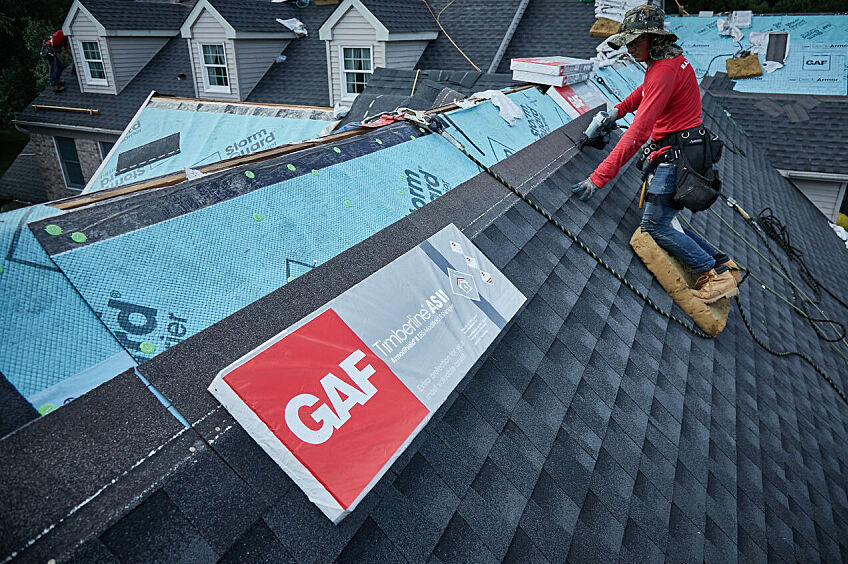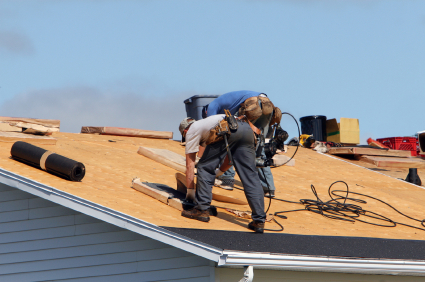Exactly How Weather Can Influence Your Roofing Longevity
Your roofing faces constant difficulties from the climate, and it's crucial to recognize just how these conditions can shorten its life expectancy. Each aspect plays a duty in your roofing's longevity, but how can you efficiently prepare for these threats?
The Impacts of UV Rays on Roofing Materials
Although you may not think of it typically, UV rays can substantially influence the lifespan of your roofing products. When your roof covering is revealed to sunshine, those dangerous rays can create substantial damage in time. UV radiation breaks down the chemical bonds in products like asphalt shingles, leading to cracking, fading, and deterioration. This degradation deteriorates your roof and makes it much less effective at shielding your home (Siding Contractor).
You can minimize these results by selecting UV-resistant roof products or using safety finishings. Routine inspections likewise assist capture very early indicators of damage, permitting you to address issues before they escalate. In addition, consider mounting reflective roof covering options that can disperse UV rays and maintain your home cooler. By staying positive about UV exposure, you'll expand the life of your roof and boost your home's total longevity. Taking these steps currently can save you cash and anxiety later.
Exactly How Too Much Rainfall Can Lead to Roofing System Damages
While UV rays can damage your roofing system, extreme rains postures one more significant risk to its stability. When heavy rains happen, water can pool on your roofing system, bring about potential leakages and structural damages over time. If your roofing materials aren't developed to take care of extended direct exposure to wetness, they can deteriorate faster than expected.
Clogged gutters can aggravate these concerns, causing water to overflow and seep into your home. You might notice discolorations on your ceilings or walls, signifying that water is finding its method inside. Additionally, standing water can advertise mold development, which not just harms your roofing yet can additionally influence your interior air high quality.
To shield your roof covering, confirm your drainage systems are clear and functioning properly. Regular assessments can assist you identify weak points before they become costly repair work, maintaining your roofing system healthy even during hefty rainfall.
The Effect of Snow and Ice Build-up
When snow and ice accumulate on your roofing, you could not recognize the stress it places on the framework. That included weight can result in significant problems like roof drooping and even collapse. Plus, ice dam formation can trap water, creating leaks and additional damages to your home.
Snow Tons Anxiety
As wintertime coverings your home in snow, the weight of collected ice and snow can put considerable anxiety on your roof covering. You might not realize just how rapidly snow can gather, particularly during heavy storms, so it's critical to maintain an eye on the weight your roofing system is sustaining. Additionally, comprehending your roofing's framework and its snow tons ranking can notify you about when to take activity.
Ice Dam Formation
Ice dam formation can come to be a significant concern during wintertime, specifically when snow gathers on your roofing and temperature levels vary. When warm leaves from your home, it thaws the snow on your roofing system, triggering water to flow down. As this water reaches the cooler eaves, it ices up, creating a dam that avoids further drainage. Over time, this trapped water can seep under tiles, bring about leaks and significant damages to your roofing structure. To protect against ice dams, make sure your attic room is appropriately insulated and aerated. You should likewise regularly remove snow buildup from your roofing. By taking these precautions, you'll assist expand your roof's life-span and stay clear of costly fixings brought on by ice dam problems.
Temperature level Variations and Their Role in Roofing System Wear And Tear
Temperature level changes can seriously affect your roof's life expectancy. As materials expand and agreement with heat and cool, they come to be extra vulnerable to splits and damage. Additionally, freeze-thaw cycles can exacerbate these problems, resulting in more damage in time.
Thermal Development Effects
When temperature levels change, your roof can undertake considerable thermal development and tightening, which might lead to our website worldly tension and damage over time. As the sunlight warms your roof during the day, materials increase; when temperatures go down at evening, they get. Routine assessments can likewise assist you catch early signs of wear, guaranteeing your roofing stays durable and reliable in protecting your home.
Freeze-Thaw Cycles
As winter sets in, the freeze-thaw cycles can inflict havoc on your roof covering. As it ices up, it broadens, placing immense pressure on your roofing products.
Disregarding these concerns can lead to even more considerable issues, consisting of leakages and architectural damage. To secure your roof covering, it's important to inspect it frequently, particularly after extreme weather condition. Dealing with minor concerns promptly can assist prolong the life of your roof covering, ensuring it holds up against the rough impacts of freeze-thaw cycles throughout winter.
Humidity Degrees and Their Result on Roof Covering Integrity
While lots of people focus on temperature fluctuations, moisture levels play a vital duty in establishing the integrity of your roofing system. High moisture can create a damp atmosphere that urges algae, mildew, and mold and mildew growth, all of which can deteriorate roof covering products with time. If your roof covering's ventilation isn't sufficient, wetness can obtain entraped, bring about wood rot and other architectural concerns.
Alternatively, reduced moisture can result in dry problems, causing products like roof shingles to end up being fragile and fracture. This brittleness can make them much more vulnerable to damage from other weather condition elements.
To preserve your roof covering's integrity, it is essential to keep an eye on moisture levels and guarantee proper air flow. Regular inspections and maintenance can go now aid identify possible problems before they end up being considerable issues. Keeping your roof covering in good problem suggests being positive about moisture effects, inevitably extending its lifespan and securing your home.
Wind Damage: A Silent Danger to Your Roofing System
Moisture isn't the only weather condition factor to contemplate; wind damage can silently endanger your roof's stability. Strong winds can lift tiles, loosen blinking, and even tear off entire areas of your roofing. You could not see these issues instantly, yet gradually, they can cause significant leaks and architectural damage.
If you live in a location susceptible to high winds, it's vital to keep an eye on your roof covering after tornados. Check for any kind of missing or damaged roof shingles and examine the edges where the roof satisfies other surfaces. Roof Contractors. Focus on any debris that might have gathered, as this can trap moisture and get worse damage
Neglecting these indications may conserve you time currently, however it might cost you a lot more in the future. An aggressive technique to wind damages can aid ensure your roof stays strong and safe, lengthening its lifespan and protecting your home.
Preparing Your Roof Covering for Extreme Weather Condition Events
When preparing your roofing system for extreme weather events, it's critical to analyze its existing condition and make required upgrades. Start by inspecting for missing or damaged tiles, as these can cause leakages throughout hefty rain or snow. Replace any type of endangered materials to assure a solid foundation.
Following, check the blinking around vents, skylights, and chimneys. Correctly secured flashing prevents water from leaking in, which can cause considerable damage.
Think about strengthening your roofing's framework, particularly if your area is prone to high winds or hefty snowfall. Setting up impact-resistant shingles can add an added layer of security.
Finally, clear seamless gutters and downspouts to promote proper drainage. Stopped up gutters can result in ice dams or roofing leakages. By taking click reference these positive actions, you'll aid expand your roofing's life expectancy and lessen potential damage during extreme climate occasions.

Often Asked Concerns
Just how Commonly Should I Evaluate My Roof for Weather Damage?

Can I Fix Roof Damages Triggered By Weather Myself?
Yes, you can fix roof damage brought on by climate on your own if you have the right devices and abilities. Simply make specific you prioritize safety and security, analyze the damage thoroughly, and follow correct repair techniques to prevent future issues.
What Roof Covering Products Are Finest for Extreme Weather Condition?
For extreme climate, take into consideration steel, slate, or impact-resistant shingles. These products withstand hefty winds, hailstorm, and snow better than others. You'll ensure your roof lasts longer, shielding your home from harsh components effectively.
Just How Does Environment Modification Affect Roof Covering Longevity?
Environment change speeds up endure your roof covering, causing products to break down much faster. Enhanced temperatures and extreme storms can result in more frequent repair work. You'll need to contemplate resilient options to guarantee your roof covering lasts longer.
Should I Consider a Roofing System Service Warranty for Weather-Related Issues?
Yes, you need to absolutely consider a roofing warranty for weather-related concerns. It safeguards you against unforeseen damages, guaranteeing your financial investment remains safe and secure. And also, it provides assurance throughout uncertain climate condition.
How Excessive Rain Can Lead to Roofing Damage
When hefty rains take place, water can merge on your roof, leading to possible leaks and structural damages over time.Moisture isn't the only climate factor to ponder; wind damage can silently endanger your roof's integrity. By taking these aggressive steps, you'll aid prolong your roofing system's life-span and minimize potential damage throughout extreme weather condition events.
Can I Repair Roof Damage Created by Climate Myself?